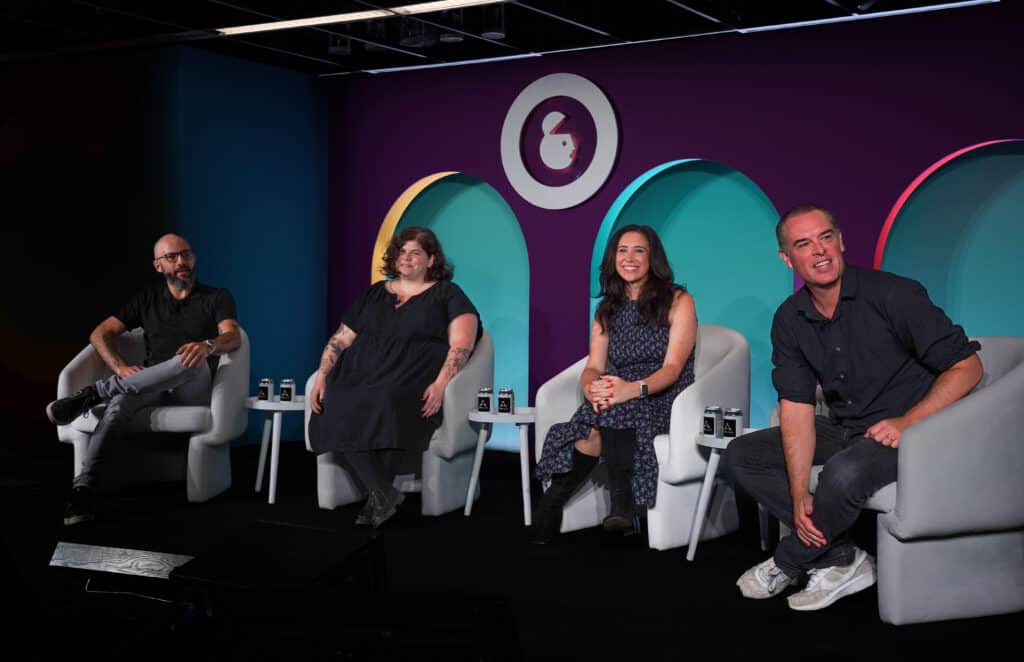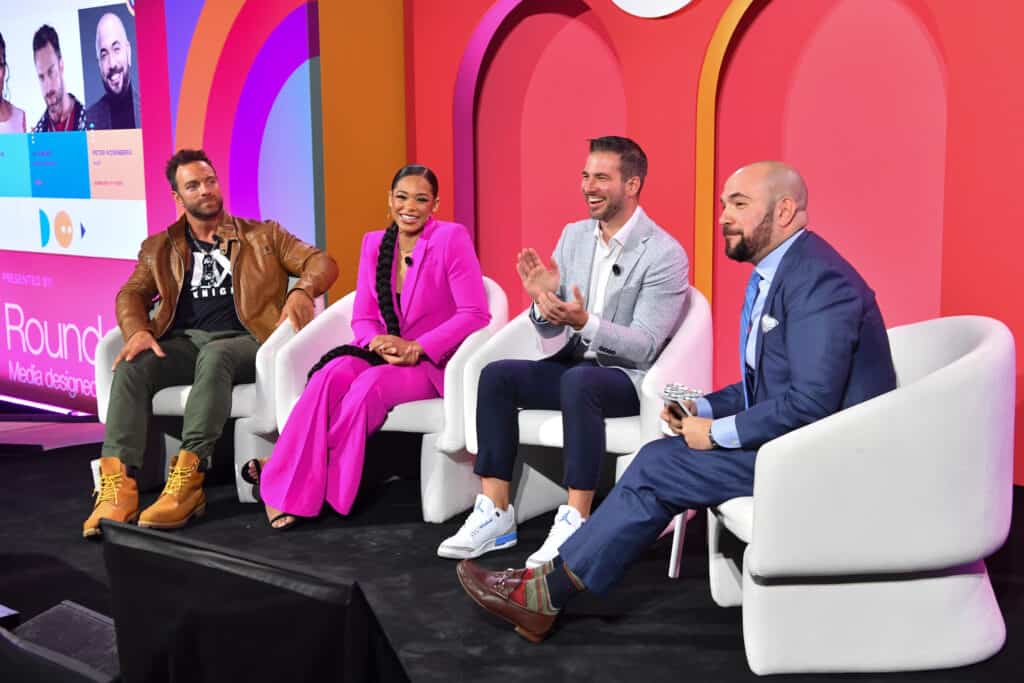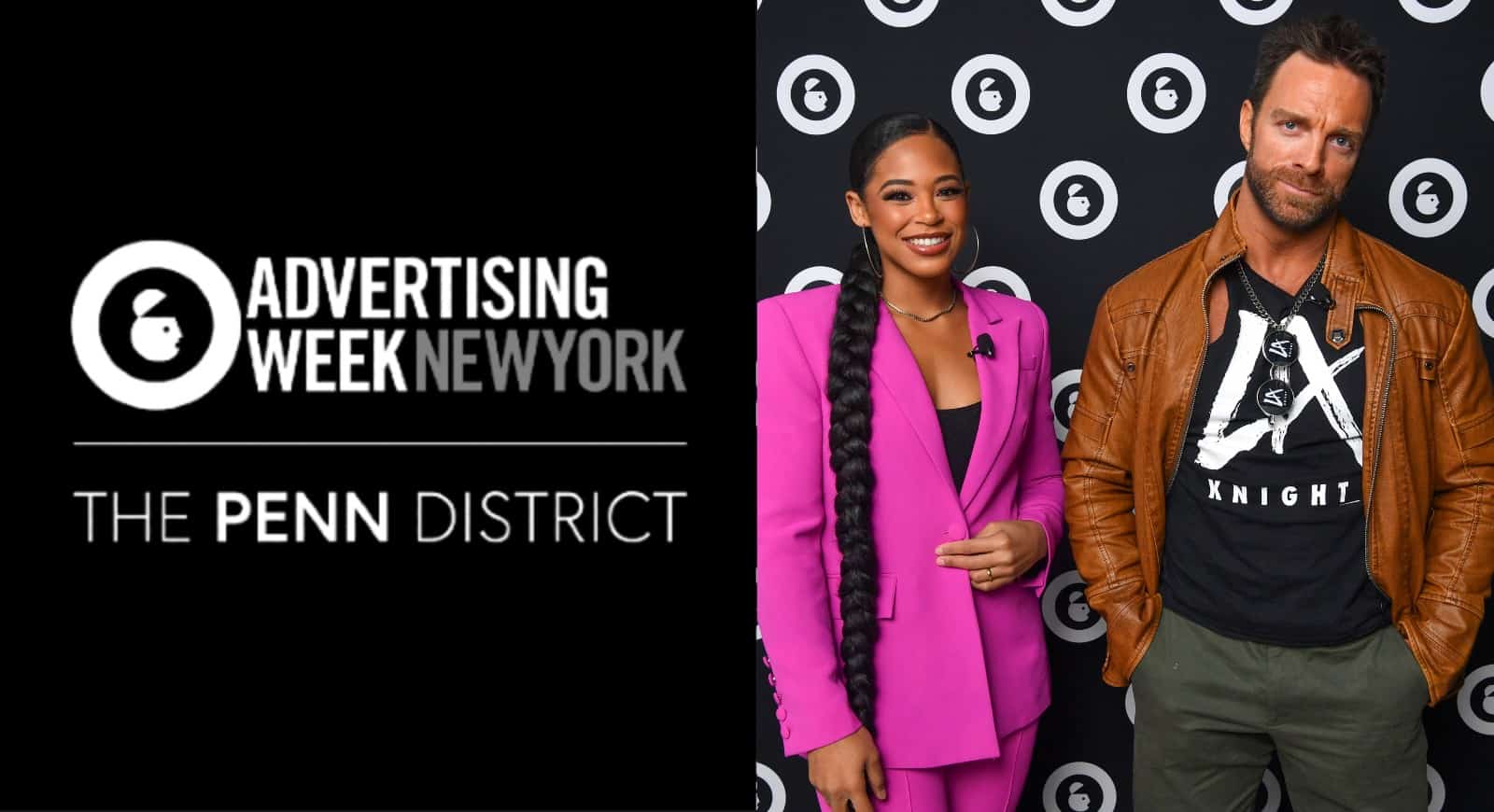Advertising Week New York 2023 has officially wrapped its takeover of Manhattan’s recently redeveloped PENN DISTRICT building. The 19th edition of its annual event brought together some of the keenest minds in marketing, media, advertising, tech and communications for four days of immersive learning, networking, and world class culture and entertainment.
Mediaweek was on the ground, attending a number of key sessions throughout the week. Here are some of the highlights from AWNewYork’s final day:
See Also:
Day one recap: Super Bowl, OneRepublic, Barbie & Paris Hilton
Day two recap: Netflix Cup, Chris Olsen, Andy Cohen & Shark Tank
Day three recap: Renaissance Woman, Crispin Porter + Bogusky, Jonathan Van Ness & Issa Rae
The Next Evolution of the Creator-Age: Building Media Companies
Sweathead CEO, “strategy friend” and friend of Mediaweek, Mark Pollard, steered the discussion between Aislinn Murray, brand director of The Botanist Gin, Camie Cox, director of integrated production for Made In Network, and popular chef and Internet personality, Andrew Rea, of Babish Culinary Universe.
See Also: Mark Pollard: Irreplaceable – the mindset agency people need for future survival
Together, Rea and Cox have grown what started as a passion project for Rea to combine his love of film and cooking, the Binging with Babish YouTube channel, into an expanded media network. The channel’s long-standing relationship with The Botanist Gin sets an enviable standard for brand partnerships with content creators.

The Next Evolution of the Creator-Age: Building Media Companies – Andrew Rea – Chef and Personality, Babish Culinary Universe, Camie Cox – Director of Integrated Production, Made In Network, Aislinn Murray – Brand Director, The Botanist Gin and Mark Pollard – CEO, Sweathead
Cox distinguished typical creator sponsorships compared to evolving integrations as part of a media network: “One-offs are really just taking a product and just giving it a quick plug, as opposed to when creators are really evolving into media companies.
“They’re really thinking about how they build partnerships… and how we are incorporating the brand in an authentic way, both to the brand, but also to the creator’s world. It’s a more thought out, robust kind of approach.”
She praised the success of Babish and The Botanist’s partnership for all parties involved, including Rea’s audience, “Because we’ve been doing this for like three years, I think that for his audience, The Botanist is almost like a character on his channel at this point.”
Talking to the creative challenges from a brand perspective, Murray revealed that the brand’s foray into a partnership was “a territory of tone we hadn’t really explored as a brand before and that can be uncomfortable at first.”
Reflecting on this, Murray was glad to recognise how effective the partnership has been in broadening The Botanist’s audience, and communicate their unique selling point (using 22 hand-foraged botanicals), “rather than just kind of reading off messages, Andrew was able to really take that information and put it into a language that was premium but fun.”
Said Rea, “It’s the instinct of the creator to integrate… so to actually integrate the product into the content. If anything, the hardest part is in the beginning. Typically, when you’re getting these ad reads that are to be read exactly as they are, it’s almost made as a separate part of the content; it’s that long section at the beginning of the video that you’d skip through. We don’t want that, we want something that’s going to engage with the audience.
“It’s been really great working with The Botanist because they, in particular, have given us the creative freedom to make the advertisements part of the content.”
Rea even treated the audience to a live creation of an integrated video advertisement, demonstrating the ease and effectiveness of its execution.
Celebrating 125 Years of Pepsi: A Conversation with Pepsi CMO Todd Kaplan
More notable Australian talent on the slate, notorious digital prophet, David Shing aka Shingy hosted this fireside with Pepsi CMO Todd Kaplan to delve into its first rebrand in 14 years.
Kaplan dissected the redesigned Pepsi logo, which incorporates elements of the past while embracing a bolder, more modern look. The new design recognises Pepsi’s 125 year old heritage while also keeping the brand future-proofed.
Kaplan expressed, “You don’t want to feel old and dusty, connected to another era, right?
“The great thing is, Pepsi as a brand has always been very youthful in terms of how it has driven culture, and connected to what’s going on around it. Over the years you can see our logo has continued to evolve. Every roughly 15 years or so we kick the tires and make sure we feel good about it.
“There’s been kind of a core ethos that’s connected throughout it all: this challenger spirit and this pop culture vibe.”
Beyond the design elements, Kaplan explained of the rebrand, “We’re building it for a more ‘phigital’ world moving forward. This idea of ‘phigital’ is kind of an annoying word, but it’s a fun word that I like. It’s intentionally the blurring of the physical and digital environments.
“In this idea of knowing that the real and digital worlds are going to be continuing to blend more and more, how do you have a consistent brand experience both ‘IRL’ and in that digital environment?… So that’s something that’s important as we built this visual identity to be flexible enough for different environments.”
Shingy also queried Kaplan about his concept of a “culture bomb”, saying, it’s “not just putting a brand somewhere, it’s about putting these experiences in play.”
Kaplan clarified, “I created this thing with my team of leaders; I call it a culture bomb. It’s basically the premise of the fact that I believe the role of earned media and organic social media is significantly undervalued in the marketing mix today relative to paid media.
“The reality is, the stuff that people care about, the culture of it all, happens in earned media and social media.”
He advised, “So rather than chase the consumer and try to follow them everywhere they go, there’s this idea of building deeper, more immersive brand experiences where they can find you, this idea of an opt-in kind of cultural environment that you can create from your brand, and creating experiences.”
Kaplan emphasised long-form content, as well as physical activations. One such example, their pop-up Pepsi 125 Diner in New York City. With a waitlist of 17,000 strong, it is one of their more exclusive experiences to opt into.
The Power of TIME: Jessica Sibley on Taking the Brand Into its Next 100 Years
Earlier this year, TIME magazine celebrated its centenary year. Arianna Huffington, founder and CEO of Thrive Global and founder of The Huffington Post, sat down with CEO of TIME, Jessica Sibley, to talk about the brand’s evolution over its 100 year history, and how the legacy publication is embracing change and innovation in its next chapter.

The Power of TIME: Jessica Sibley on Taking the Brand Into its Next 100 Years – Arianna Huffington – Founder and CEO, Thrive Global and Jessica Sibley – CEO, TIME
Huffington posed to Sibley, “DNA can degrade over time. So how are you ensuring that the brand stays true to its DNA and to its core mission of storytelling, while continuing to evolve and to innovate?”
Sibley asserted that the TIME’s red banner represents, “a globally recognised significant thing that we’ve had for 100 years, which is trust. Our mission and our purpose for the last 100 years will continue to remain the same today and going forward.”
As part of that commitment, Sibley oversaw the removal of the paywall from Time.com. She shared, “I’m really proud given the moment that we’re in right now, in history, that TIME is free for anyone everywhere in the world.
“And it’s not just what we’re writing about today, but it’s our 100 years of archives that are available to students to parents, to universities, colleges, to libraries, for free.”
Sibley elaborated on their editorial strategy, “we launched TIME100 Voices. We don’t just want to have our own editors and journalists to write for TIME. We want people who are leading experts and thought leaders and part of the TIME100 community to participate and write for us,” listing the examples, “We launched with Jose Andres, Oprah Winfrey, Eric Schmidt, we’ve had the CEO of Accenture and the CEO of Google.”
Further TIME’s future-focused strategy “to stay on everyone’s radar”, in Sibley’s words, “going from legacy to relevancy,” she spotlighted Sam Jacobs, their “amazing editor in chief, the youngest editor and our 100 year history at 37, the first millennial to run TIME.
“He’s been there 10 years, so having someone who’s so well respected and who’s so steady is so important right now.”
She lauded TIME’s befitting timelessness, “it’s what we write: it’s who we write about, it’s who we write for. I’m so proud that we have the youngest audience in our 100 year history; 45% are 35 and younger.”
Stepping Into the Ring with WWE
When it comes to the unique marketing opportunities of WWE (World Wrestling Entertainment) and its departure from regular sports partnerships, Craig Stimmel, senior VP and head of global sales and partnerships at WWE, was eager to convey to the Advertising Week audience, “something I don’t think a lot of people realise is outside of a company like Disney, I think WWE has the most IP ownership of any company in the world.
“Anything that you see happen in that ecosystem, anything that you see happen on Peacock, on streaming, on linear TV, on social. digital – that’s all under WWE IP ownership.” Plus that extensive IP ownership just got even bigger with WWE and UFC merging under Endeavour’s ownership. The creation was a $21 billion venture representing over 350 plus live sporting events a year.
Someone on the frontline of the sporting business, moderator Peter Rosenberg, ESPN/Hot 97 host, captured the special energy of WWE that resonates so intensely with its enormous audience, “You can bring your little children, and your grandparents, and it’s just great… You don’t leave WrestleMania going ‘well, that game stinked.’ It’s always a great show.”
Naturally, with its larger-than-life canonical universe, spectacular live events, and cult followings, WWE represents a significant talent pool of personalities for brands to leverage. WWE Superstars LA Knight and Bianca Belair are currently two of the largest names under the billion dollar umbrella.

Stepping Into the Ring with WWE – LA Knight – WWE Superstar, WWE, Bianca Belair – WWE Superstar, WWE, Craig Stimmel – Senior Vice President and Head of Global Sales and Partnerships, WWE and Peter Rosenberg – Host, ESPN/Hot 97 Host
Stimmel remarked, “One thing that we’ve seen at the WWE and it’s by no small feat, of these two over here and the other 250 Superstars, is we really have Superstars that act as content creators.
“If you look behind the scenes at these folks’ Instagrams or social media handles, or even the behind the scenes work that we do on our social platforms, you’ll see that Bianca is actually an incredible seamstress. She does all of her own costumes and her husband Montez Ford’s costumes as well. You would see that LA Knight was a Timberland guy before he was LA Knight.”
Knight and Belair both feature in the latest version of longtime WWE sponsor, Slim Jim’s Snap into a Slim Jim campaign, continuing on from the snack brand’s iconic affiliation with late WWE Star, Macho Man Randy Savage.
Knight weighed in on his involvement in the ad campaign: “I mean, you’re mixing a little bit of the old with the new and you know, giving new life to something that hasn’t been around for a while, and also paying homage to the OG. So it’s pretty cool.
“And it’s the first time I’ve ever busted through a wall.”
Sharing her approach to brand sponsorships, Belair said, “I love doing collaborations when it’s authentic. So I’m really excited for those that are authentic to my character in the ring and my personality outside the ring.”
For the latter, Belair mentioned her existing connection with performance brands like C4, “I was using C4 before I ever even got into WWE.” Moreover, she highlighted how collaborating with brands like Fenty aligns with her values of diversity and inclusion, “they represent the things that I represent.”
–
Top Image: Bianca Belair & LA Knight
